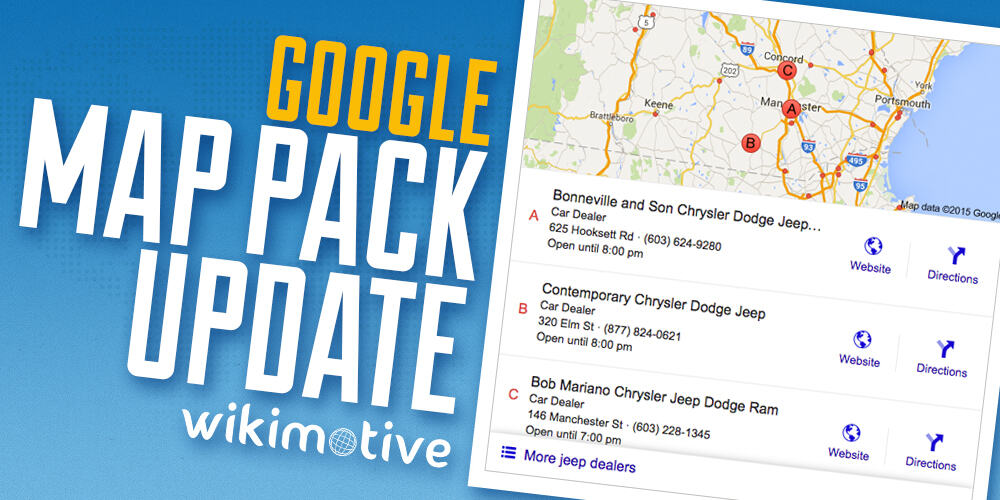
Local SEO has become one of the most important focuses in the digital marketing community. This means it’s only natural for everyone to take notice and rethink strategy when Google makes an update to its local Map Pack results.
In its latest update, which occurred around August 6, 2015, Google redesigned the Map Pack to fit with its mobile design scheme and reduced the maximum number of results from 7 to 3.
A lot of business owners went to sleep seeing their business on page one, but woke up completely pushed off. As SEOs and business owners, what are you supposed to take away from this change?
In this post, we’ll explore five of the most important thoughts and takeaways from the latest Google Map Pack update:
Local Rankings Matter Even More
While it’s always been important to rank #1, it’s more important than ever to ensure your business actually shows up within the map pack, as there are now only 3 positions available on the initial SERP. (In order for users to see more results, they’ll have to click through to Google Maps.)
This means more businesses will likely begin focusing on local SEO and the top 3 may beef up their efforts in order to stay on top. There’s no more coasting by in the bottom 4. It’s time to invest in local.
Google’s Focus is on Improving Mobile Experience
In May 2015, Google officially stated that it’s receiving more search queries from mobile devices than desktop devices in ten different countries, including the U.S. and Japan. (This actually contradicts data from comScore, which showed that smartphone and tablet searches accounted for only 29 percent of the market at the end of 2014.)
We don’t know more than that, but it’s obvious Google is focusing on improving its core search experience
more than on desktop.
In recent years, the company has been preparing us for the mobile takeover by suggesting responsive web design, which allows a site to conform to various screen sizes, is best practice moving forward.
With this change, it’s clear Google wants to blend the desktop and mobile experience, and this update is just another step in making that happen.
Too Many Choices
Many experts believe that Google reduced the number of businesses in the local pack because CTR among the bottom results was extremely low. This does make sense, as Google’s job is to quickly provide users with the best results in order to better connect users with information.
It’s also possible that Google provided too many irrelevant results for many search requests. Not on purpose, but just by design of the previous Map Pack. With the new design, they’re able to keep the results as relevant as possible.
In a recent Moz post, Casey Meraz displayed user tests in which everyday people interacted with Google’s new Map Pack. None of the users were taken aback from the lack of 7-pack results, but were confident in making a decision based on reviews and ranking.
Less Website Traffic
Because of the new Map Pack design, it’s likely most businesses will receive less traffic, despite there being less competition.
Why?
Because of the design change. Instead of the business name appearing as a clickable link, most of the listing displays as clickable.
But unlike the previous Map Pack design, it does not direct the user to the business’s website. Users are now directed to a new SERP that brings up the local map and prominently displays the business’s full information.
There are buttons on the Map Pack that link to business websites and provide directions, but users are accustomed to clicking on a business’s name or title in order to get the website.
In fact, Casey Merez also did a heatmap test with the new Map Pack, which showed users click more on the business name than on the website. With this data in mind, it’s possible this new design could be cause less traffic to funnel to business websites.
Google+ Deprioritized
By now, we all know that Google+ has been a failed experiment. The search engine company’s social network showed a lot of promise when it was first released, but failed to catch on with everyday users.
In the past couple of years, Google has slowly been moving as far away from Google+ as possible without completely shutting down the service.
First, Google shut down its authorship program, which allowed journalists and bloggers to claim content and appear in search engine results. Next, the company removed the requirement of a Google+ account with YouTube.
Now, with the latest Map Pack update, Google has removed the link Google+ (My Business) page link from local results. It’s actually impossible to now navigate to a Google My Business page from SERPs.
And while some experts believe Google+ votes are a local ranking factor, I believe it’s likely that posting content to a Google+ page is a waste of time.
At the end of the day, Google is going to make the changes it wants, regardless of what the SEO community thinks. So whether you’re an SEO or a small business owner, take this information and use it to provide your clients with better results or better prioritize business marketing for the future.